Katie West and Michael Gentle
“Conversation on Rockpools”
Offering insight into Rockpools, Katie West, Yindjibarndi woman and artist, spoke with Michael Gentle, Nyoongar man and Curator, Australian and First Nations Art, National Gallery of Victoria, about the stories, places, histories and futures held by the work.
The following is an edited transcript of the conversation that took place.
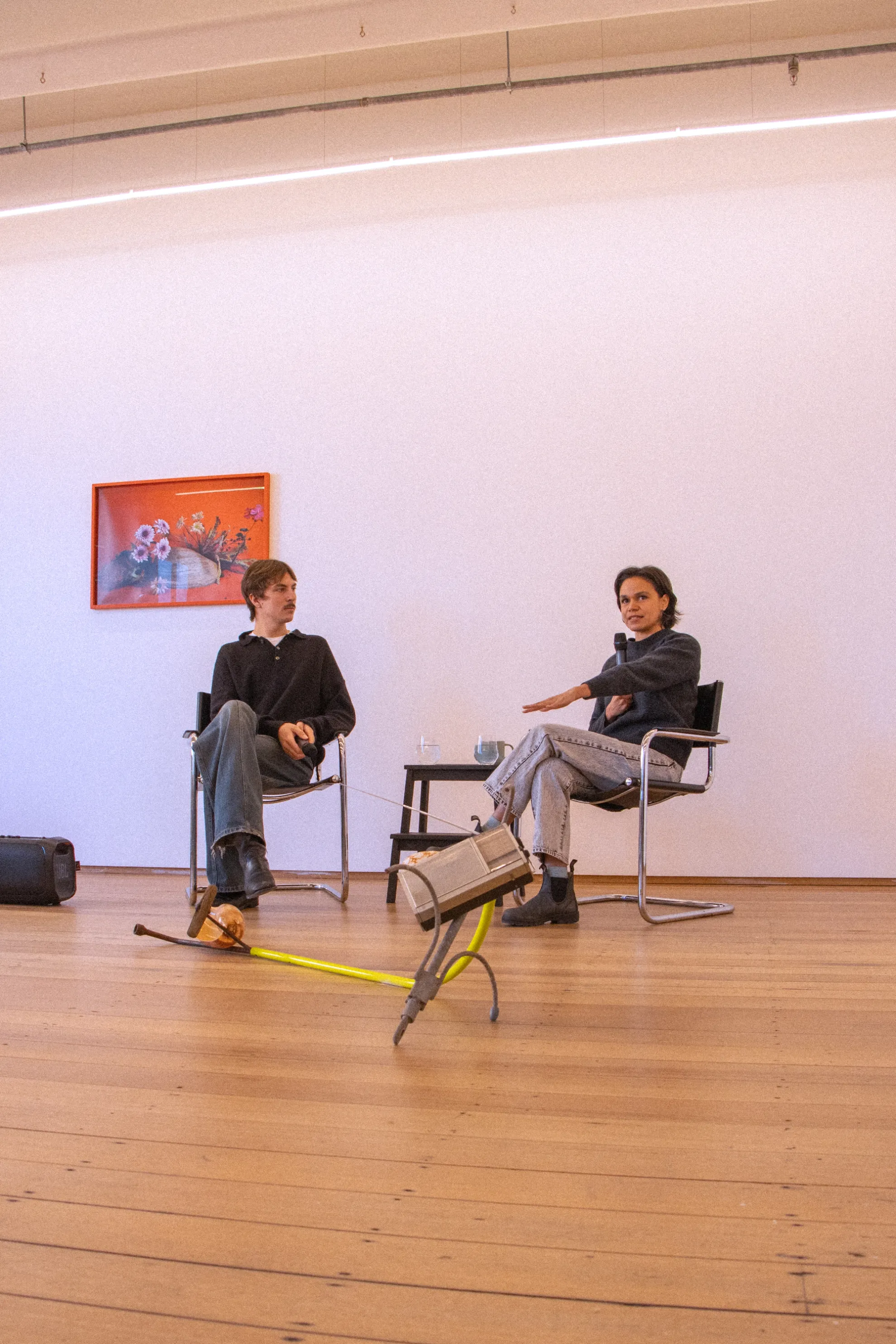
Michael Gentle: I’d like to begin by acknowledging the lands that we're on today, of the Woi Wurrung people of the Kulin Nation. I pay my respects to Elders, past and present, the broader community, and all the work that they do, and their religious and cultural practices which sustain the cultural heart of this city and the broader regions around it. I am a Nyoongar man with ancestral connections to Menang Boodja, which is around the Albany area of the deep southwest of Western Australia. I'm excited to talk with Katie West today, one of my icons of the art world.
Katie West: Thank you, Michael. I'd like to first acknowledge the Wurundjeri Woi Wurrung people as well. I'm a Yindjibarndi woman from the Pilbara region in Western Australia, and currently live and work in a little town called York on Noongar Ballardong Country, just east of Perth.
For this work, I was supported by Regional Arts Fellowship to go up to the Pilbara and do some family history research, and my proposal was to look into my mother's separation from her mother in 1969 and then spiral into that story from building my understanding of my heritage as it relates to Yindjibarndi Country, and the whole of the Pilbara, looking at the colonisation in that area, the establishment of pastoral stations, and the waves of mining in the region.
I want to understand my family's experience more deeply through that history, and build my capacity to imagine their lives day to day, working as domestics and stockmen in particular. I'm fascinated by that time because people were essentially in a circumstance of being indentured slaves, but also still able to tend to Country. Whereas, once people were moved onto reserves around the town camps, that ability to look after Country directly was damaged to another level. It was my curiosity that led me up there.
MG: Something that has been a through-line in your practice for a while now is navigating small steps in the grander investigation into who you are and where you come from. We have spoken about not putting too much pressure on yourself in the discovery of these things because they are difficult and sensitive. A lot of our shared family stories have these resonances.
I have enjoyed talking to you about the idea of 'imagining' — visiting the Pilbara and imagining what your family were doing and how they were being treated.
Katie and I both grew up in agricultural regions, with families that didn't have a lot of connection or language, which is the portal to being connected to Country. We discussed being on Country as a child, sitting on the farm, loving where you are, and imagining what it would be like, through eyes that have not been trained in that way, but knowing that it sits within you.
I'd love to know more about this process of 'imagining', Katie, and the way it has manifested in Rockpools.
KW: With this work, I was thinking about the rockpools across Country. The kind that you find when the tide has gone out, the rockpools or all the places of permanent water that are important for people's lives, and as birthing places as well. I often think about women by the water doing all sorts of different things, particularly birthing and caring for babies and kids — the nursery experience around water.

MG: I love that in the rockpool assemblages, which are kind of the central works on the floor, things like water are alluded to as well through the Bailer shells, which in the text that accompanies the show, there's a beautiful anecdote about how the shells also use the rock pools as a nursery site and I think that resonance between the shell as not just a static object, but this living site of interaction between animal kin and Country resonates so strongly with how women interacted with these sites as well, and it's this beautiful reminder that on Country these objects aren't separate from how we conceptualise ourselves as human. They're inherently a part of the process of being and becoming, and moving towards a holistic view of who we are, but of course, the shells are resting atop of these found objects from the tip shop or otherwise. You've used found material for a long time in your practice. Could you tell us about the sources of the metal pieces in the works?
KW: There are a few pieces from the Karratha Tip Shop. I love tip shops — I love searching for and finding things. Some of these pieces we bubble wrapped and flew back down to Perth, and then they were bubble wrapped again and brought over here.
Others were collected at tip shops near where I live. I love the chance of what you can find dictating how the work is going to turn out. But also, with using metal in particular, I think about the iron ore that's being mined across the Pilbara. I wonder about the origin of the ore to make this metal. It's quite likely from the Pilbara, there's that other connection to Country on the biggest story of extraction within it.
MG: Right, many sites in the Pilbara are used by archaeologists and anthropologists to calculate how old the earth is. These materials begin in these places on Country and then over time, through imperial and colonial intervention, manifest into what we see before us. It takes a special eye to look at something and search for something gentle within these otherwise very harsh objects.
How do you negotiate treating these objects as remnants or embodiments of Country, while representing the violence of agricultural and mining practices?
KW: For me, it's about acknowledging our enmeshment in systems that we don't want to be a part of as well. We just are, and we don't always have a choice. The materials are a bit about that. I wish all of the mine sites across the Pilbara and other places would just pack up — but I also understand that it is people's livelihood. Personally, I've tried to avoid any kind of funding associated with mining. On the other hand, I have family who work for BHP and have been able to create more comfortable lives for themselves and their children. I think this is just the complexity of the world we live in, and the materials carry that story for me. I don't have the answers, but it's about understanding that and what can you do within that complexity.
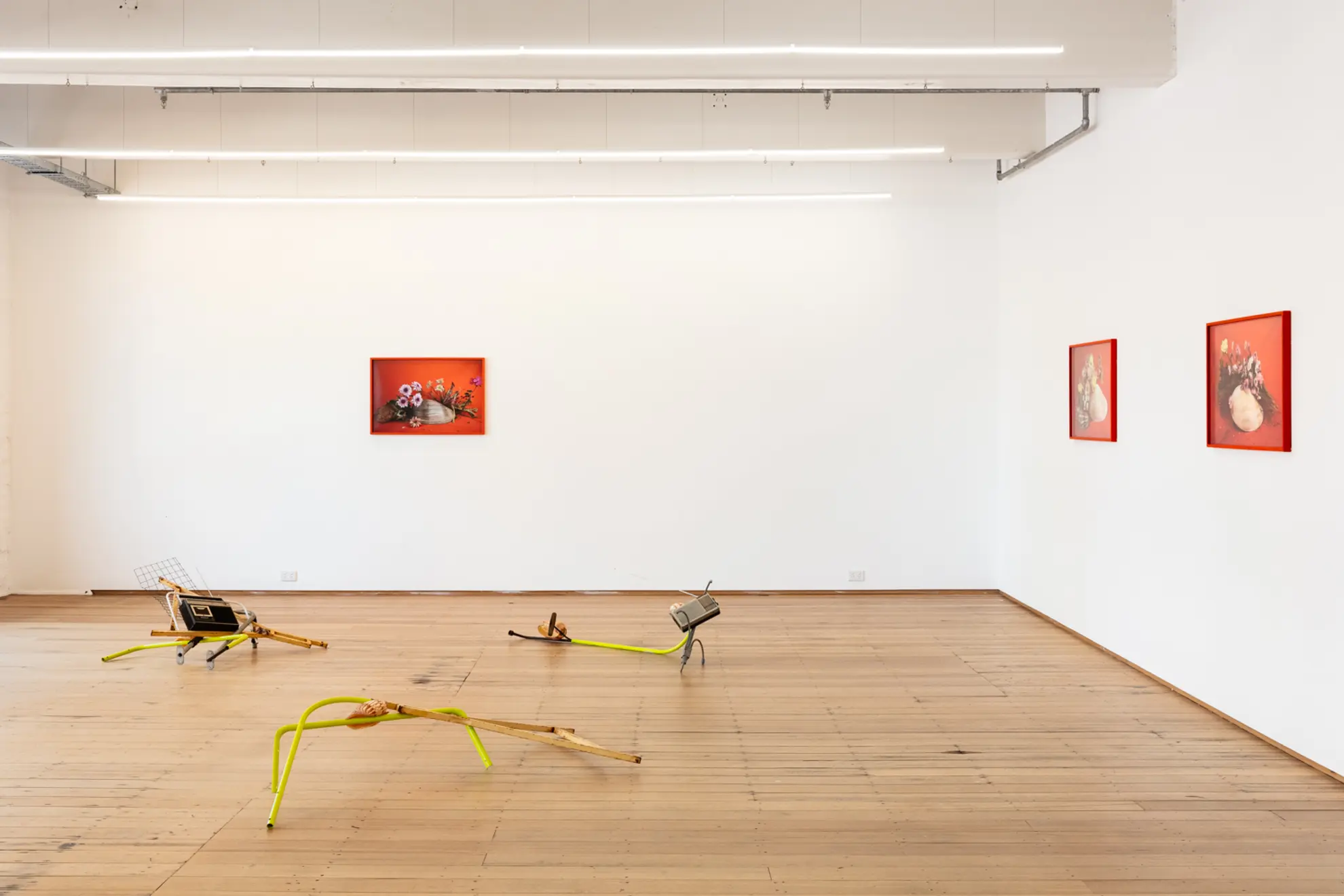
MG: Decolonial theory has also played a really massive role in your practice. You've studied sociology as well, so that current has always been there. Personally I have found that a lot of the time callings for decolonial practices, curatorially, art-historically, in art making and whatnot, they tend to be quite quick and want a lot of speed and a lot of quick, definitive answers to how things need to be, and that's not necessarily coming from Aboriginal Peoples either. It's kind of the external pressures wanting to create something decolonial that is very linear and neat and comfortable. But, we know as being enmeshed in these systems that the ambiguity is a part of decolonial practice, and things do take time.
MG: Just last night in Paris, the Murujuga was placed on the UNESCO World Heritage list, making it the second site in Australia to be acknowledged based on First Nations cultural significance. That didn't just happen over night. It has been decades of activism by local community. But then, from a Western perspective, perhaps, this decision by the UN just happens, and now it's all resolved. Even before when we were talking, the first thing you said was “it's amazing — but it's just the beginning". In your practice, there is never a definitive answer around what to do, instead you offer space to think about things.
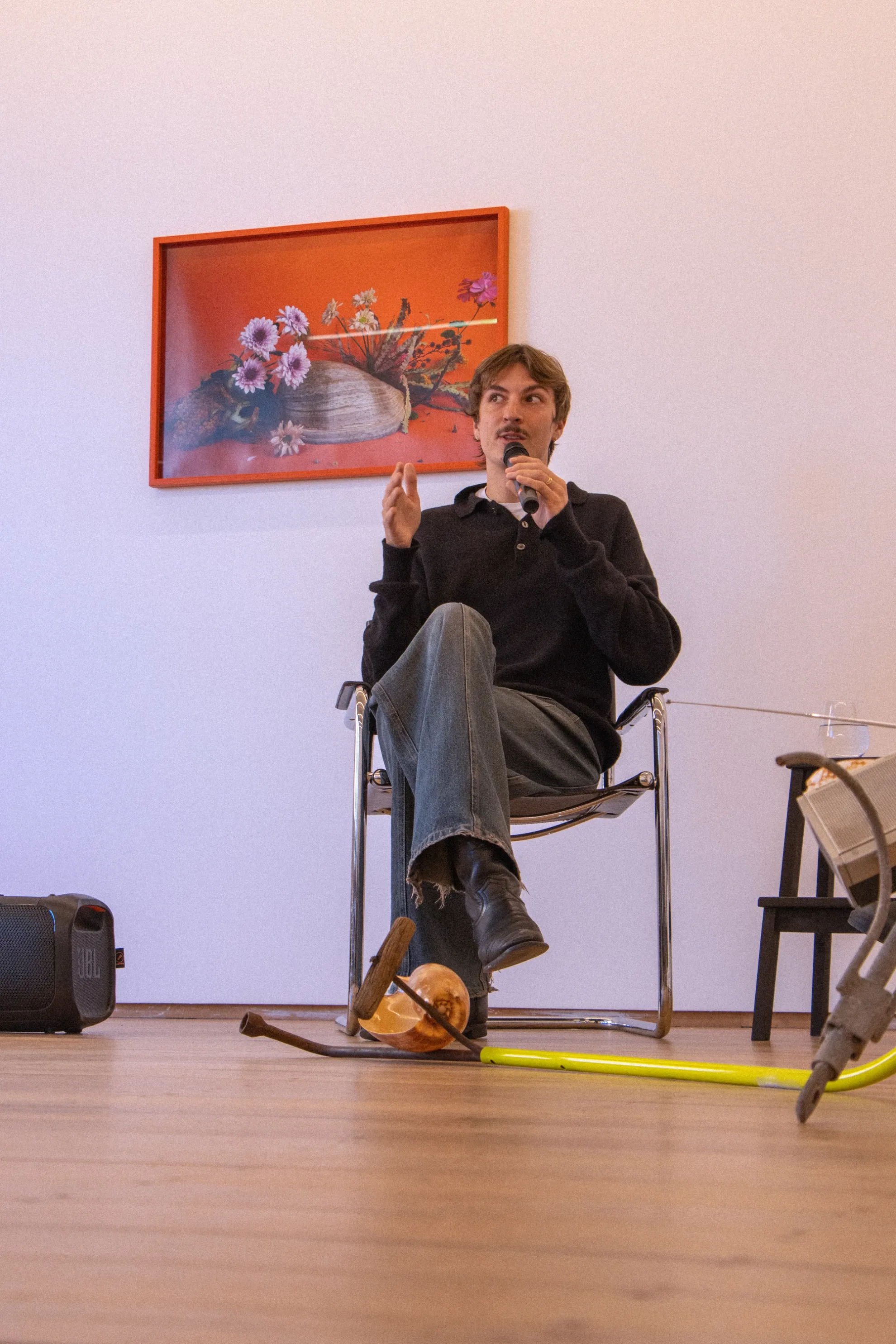
MG: Katie, your practice was one of the first that I really engaged with. I'd never really been to an art gallery before, and then when I got the job at PICA [the Perth Institute of Contemporary Art], your solo show was on at the time, and because there wasn't an art teacher telling me, "this is the answer, to what does this symbol mean" there was just this beautiful openness to exploring. It would be great to know more about not putting pressure on yourself to find a definitive answer to all of these insurmountable problems.
KW: I suppose the context I grew up in. My mum was adopted by a white family and I was brought up by them. In country Western Australia, maybe other places in Australia too, there are stereotypes around what it is to be Indigenous, and that really was the messaging I received without adult role models in my life. So I've been seeking people out. Through university I connected with lots of different texts by First Nations people, and then as time went on, colleagues who were Indigenous, and then artists. I remember having a real moment at PICA. It was the Australian Indigenous Art Triennial, possibly in 2008. I was at art school at the time and I went into the exhibition, and was looking around thinking, "okay, I'm on the right track." Seeing that I was having the same thoughts and feelings that all of these diverse artists within that show were having was quite pivotal. I could see that art was a space that could support a process of growing my sense of self.

MG: Another element of Rockpools and a through-line in a lot of your works is sound made in collaboration with Simon [composer and sound designer, Simon Charles]. Can you tell us a bit about the sound in this work?
KW: I was following on from a previous work that was shown at The National [pictured below]. For that work, we used radios to transmit a composition into the space. Growing up on a farm, a radio was playing everywhere, wherever my Grandad was working. Using sound transmitted via radio became a way to think about whose voices are privileged in this space, about Ancestor’s voices and songs broadcast across Country.
With Rockpools, I was thinking about the rock pools and the connection to water in the Pilbara. A big feature of the composition is the hydrophone recordings.

During my National Regional Arts Fellowship and residency in 2024, Simon and I stayed at a place called Point Samson, on the coast in the Pilbara. Simon would make hydrophone recordings while I was looking after our nearly-two year old son. He’d bring them back and we’d listen to all these amazing If you listen closely, there's some really bizarre sounds. There were whales there at the time, and we thought we were hearing whales one night and getting very excited about that. We don't think they are now, they're likely a big fish..
The hydrophone was a way to think about things that are submerged, that we can’t quite see the full picture of. And also of Murujuga in particular, a site of tens of thousands of petroglyphs. The cultural landscape continues into the ocean, it was a place inhabited by people before sea level rise, and I was thinking about the life of the Ancestors under the ocean, layered with the industry at Murujuga.
Within Murujuga, there's a big gas hub — if you can imagine going to Stonehenge or the Pyramids and there being a gas hub right next to it — that's how it is. You can smell gas when you're there. When we were up there, they were clearing the way for building a fertiliser plant as well. With that industry, I was thinking about things like the Bailer shells and the sea slug that lives in those. All of those little creatures that disappear when something like that is built.
On a previous trip, I went on a tour with Clinton Walker, and he was talking about how when they built the gas hub, beaches were built over the top of and green sea turtles came back to nest, and their beach is gone. I thought, that kind of destruction just kills me. That was a major reason for the hydrophone recordings — to bring back those multiple stories.
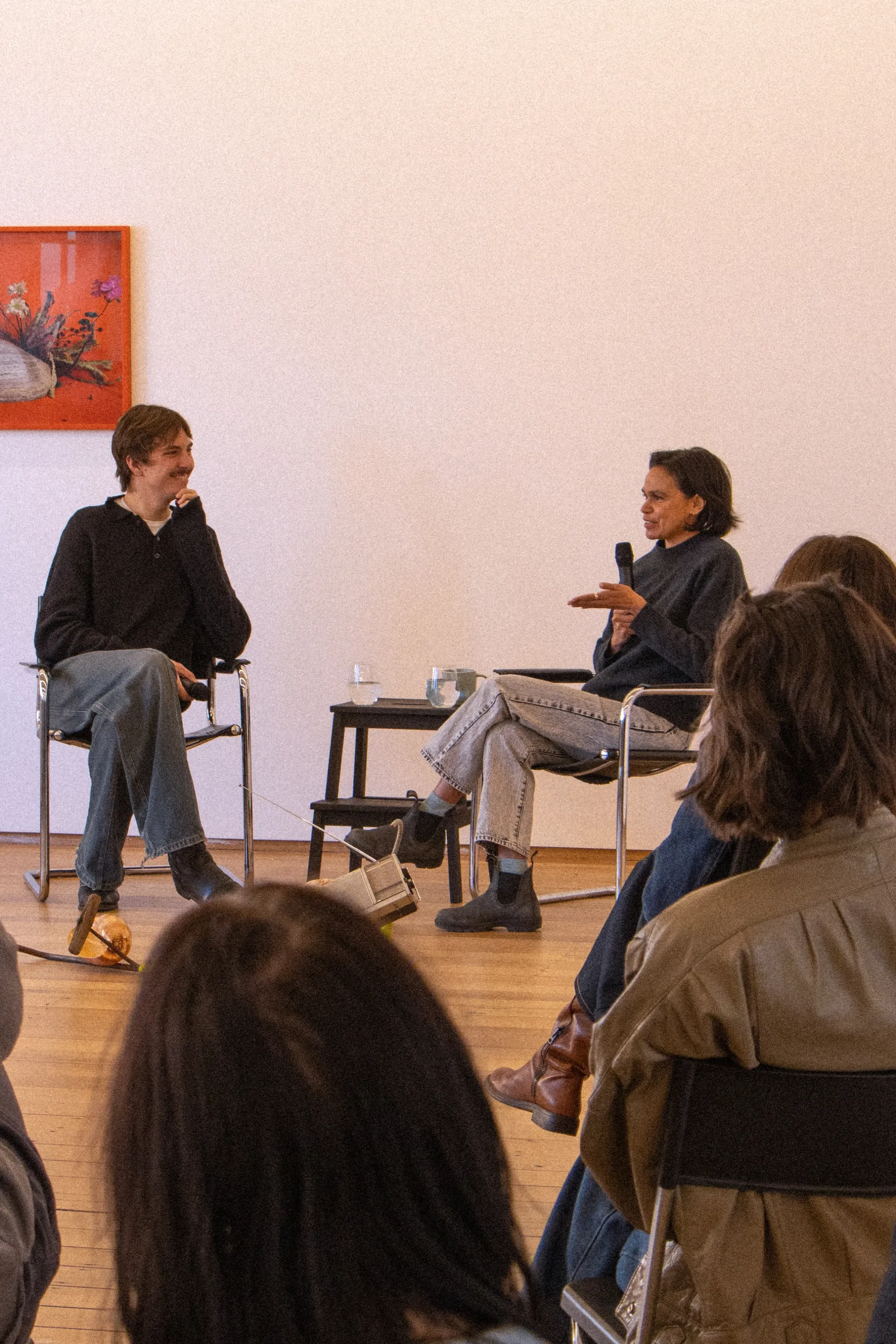
MG: You have made me think about the kind of circles of coloniality that Australia has moved through. If you read very early writings by settlers or botanists who'd traveled here from Europe, a lot of what they say about the landscape is that it's horrid, it's grotesque, it's ugly. Barron Field called it the fifth part of the Earth from hell, but then they see these kind of exotic moments, like a native flower that they hadn't seen before, and it's this kind of Holy Grail of exotic Victorian exoticism and beauty. And then as we've moved closer and closer and discourses about climate change have become more significant, there's been this shift as well to allies and settlers celebrating and needing to protect Country very rapidly, and it's really important. We need to do it right now, and at the same time have also started to either co-opt, but also celebrate First Nations knowledges as well, which underpin this environmental consciousness. But all of that kind of happens in this thwarted way where we still have these issues playing out, which don't necessarily make the mainstream media. We're in this weird place where particularly First Nations artists are revered for their depictions of Country, their celebration of their sustaining of that landscape. Yet, we have all of these programs funded by places like Rio Tinto and BHP, which makes me think of Fred William's Rio Tinto series from the 1970s, which is this beautiful celebration of Yindjibarndi Country, but was funded by Rio Tinto as well. There's issues in the way people like to separate out First Nations knowledges, artistic practice, but then the protection of what sits at the center of it all, which is Country. It's weird having to navigate this triangulation of issues at the same time.
KW: Yeah, I don't have any answers, really. I've seen women from Yindjibarndi, women from Roebourne, getting into their own art practices and they are supported, often supported, by these mining companies. It's that enmeshment.
MG: ...and the balance between economic liberty and agency, which is cool, and being able to live on Country with a stable financial income, which, of course, is the most important thing, to be able to live on Country and sustain yourself and your family, but the roots of getting there can sometimes be very muddy, but I suppose through the framework that you're thinking about in terms of enmeshment, I don't think we would want to criticise these people for going down that route, because the systems at play have positioned them there. We have to do what we can to support that process as well. I suppose, for you particularly, working a lot off of Country, and working on Nyoongar Ballardong Country, and in previous textile works, for example, dying textiles with plant matter found on Nyoongar Ballardong Country, how do you find bringing these two worlds together for you? Having lived primarily on Nyoongar Boodja, but then, having ancestry in the Pilbara?
KW: Good question. Yesterday, we were talking about growing up on farms — as a kid walking around on a farm, you begin to know every single inch of it. That experience has allowed me to draw a bow with what it might have been like, or what it is like, for some of my family who know Yindjibarndi Country really well. Nyoongar Country has taught me it doesn't matter where you are, you are interacting with Country, and you're constantly being taught and learning how to be there and to navigate it.
MG: Absolutely. We have a responsibility, wherever we are, to respect the cultural protocols of that place, and we're really the representatives of our ancestors.
Playing between these two places and these multiple positionalities that you bring to your work offers First Nations and non-Indigenous audiences an open door to understanding that positionality is complex, and holds multitudes. There isn't one linear idea of ourselves — we bring the context of tens of thousands of years to our experiences and the way this is expressed in our genes and also our socialisation. We have control over some parts of that, and others not so much. I think your work invites people to consider where they come from and how they bring that to every day life.
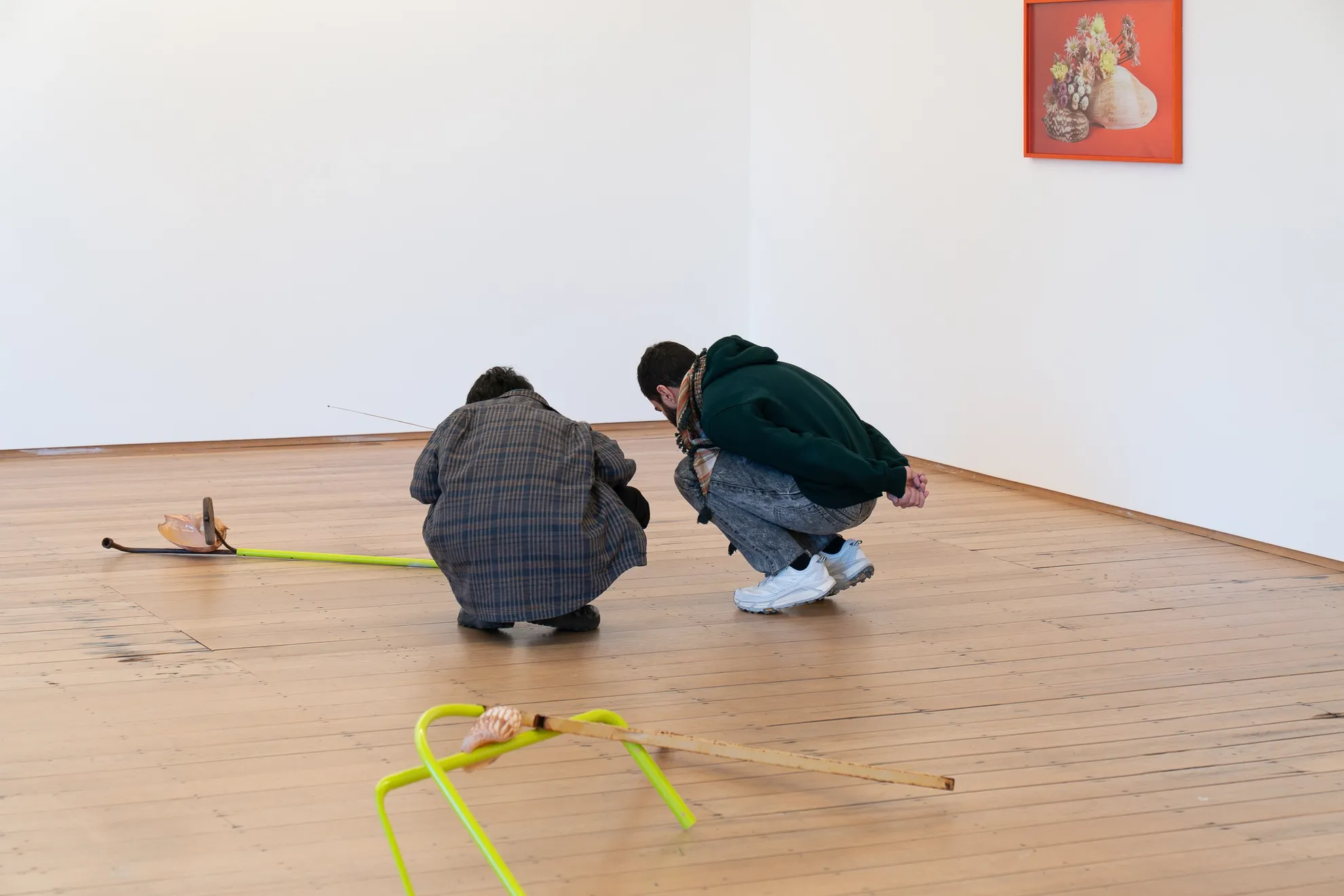
MG: One thing we haven't spoken about yet are the three beautiful photographic works. Do you want to speak about those?
KW: The photographs in Rockpools are for three generations of my grandmothers — [gestures to each photograph] — Nana Shirley, Nana Sheila, and Granny Wuggi. Granny Wuggi is my great grandfather's mother. Through her, I have a connection to Murujuga. She had many husbands, and one of them went through the lore and knew Murujuga well.
I might talk about Sheila and Wuggi together because they're buried in the same cemetery in Onslow. Part of the trip was going to Onslow and trying to locate their graves. I went to the Shire offices and asked for any information on the cemetery and they gave me a very strange map made out of an Excel spreadsheet to go and find their graves. When we went there, it was just chaos. There were numbers everywhere. I managed to get a bit of an idea of the locations where they were buried and I had a bit of an experience. We're walking away and I turned back and I felt like I could see Nana Sheila's funeral in particular, and felt I was shown the weight of the sadness of her funeral. Sheila passed away in childbirth. That was a significant experience.
The other part of that was thinking about the cemetery later when we were home. Some of the graves weren't marked, mostly, they weren't marked, but some of them were marked with these giant Melo Amphora shells. These are printed to replicate the size the shells actually are — about 30cm wide. I also wanted to mark their graves. Nana Shirley's grave is at Roebourne Cemetery, which is much more organised, and you can actually locate people's graves, most are marked well, but Shirley hasn't got a headstone. So making these works was about marking their graves in a sense. I've kept the shells and I might actually mark them in real life with those shells.
MG: I think about shells as these water carriers and utilitarian objects. And these cemeteries which haven't been kept, and were probably never made to be kept, being addressed with these shells now as these holders of water, these vessels that hold the most regenerative thing in our world, that everyone's related to water. You've spoken about before, water always being where we're from in many ways, and I love that marking the cemetery with the shell is almost bringing back this regenerative quality to the grave, rather than the cemetery, which is generally kind of a dead end to someone's life, but kind of bringing back this circularity to life and death, and ancestry through the shell, which I think is really special, and some of these flowers as well, which dry for a very long time and don't wilt. I love that, which is special.
KW: We called them Melo Amphora before, but these are Baler shells, which more people might recognise that name. The story is that explorers saw people bailing a canoe out with a shell as they're now called Baler shells. But yeah, they are water vessels.
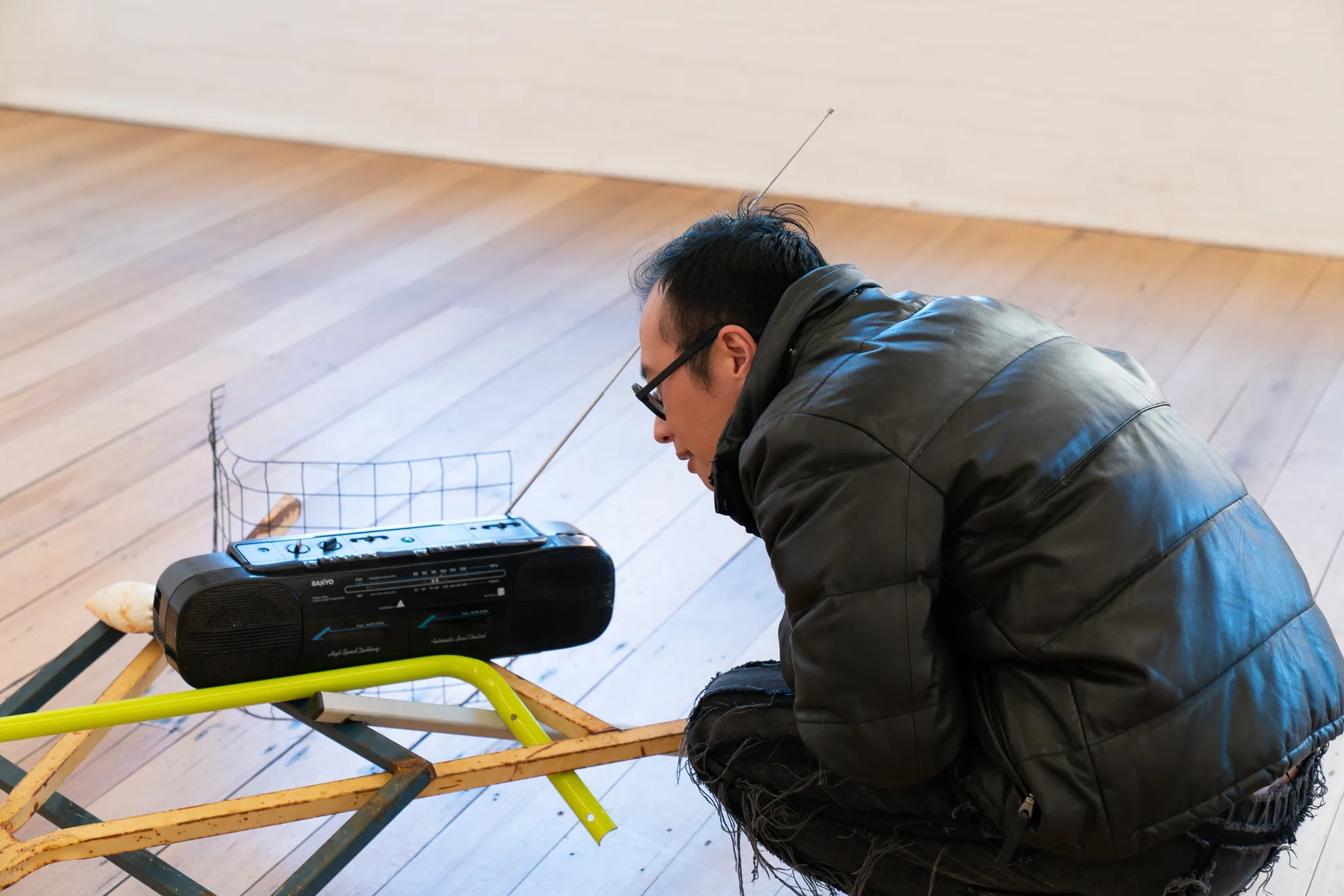
MG: It's very special to put life back to these people as well. And it's also making me think back to the kind of conversation about decolonial art making. A lot of your work, particularly the photographs as well, and the radio transmitters, I feel like you're not necessarily always moving towards grand universal claims about what your art practice can do, which I think some people can fall into a trap to. Your works are so deeply intimate with your specific context. For me, that's what makes them accessible — what you've set out to do always feels manifest, because the reach of your works is touching the people that you know and that are in your kinship circle. It makes me think of Archie Moore's Venice work, kith and kin. A family tree is maybe the most personal thing you can do, and it's those works which do the most work in kind of showcasing to people the power of art when it comes directly from who you are. Has it been an interest of yours to make universal claims about Aboriginality or Indigeneity in Australia?
KW: Never. Never. No, and I think my positionality, the disruption to my family, I feel very uncomfortable doing it. It just doesn't make sense to me.
MG: I think a lot of people on our side of the fence would probably feel like that, which I think is testament to the way that these rules of respect play out as well. You and I had a brief conversation yesterday about going back onto our ancestral country, of which I didn't grow up on. I grew up 400 kilometers north from it, and you grew up on Ballardong, Noongar Country, and kind of having this nervousness sometimes, or a bit of anxiety going back, because you know your family is from there, but you feel almost like a guest in your own homelands. Did that play out in the work at all?
KW: Yeah, it does and it's a work in progess. When I was small, my adoptive grandparents would take me up there, like every second year, and then Nana Shirley passed away, you know, around about 1996, since then, it's been really just me going up as an adult. It's been a few trips, and really, I'll just do that for the rest of my life. I think I just accept that it's uncomfortable, like, even this trip now, I was feeling a bit shy and I didn't really catch up with too many people until the last week. And I was like, "Oh, I better go, try and see some people." The Nana I usually connect with, she was very busy with the UNESCO World Heritage stuff. They had just hosted someone from the UNESCO. So, I didn't get to catch up with her. It's just going to be little by little, but there are people I have met who are older than me, who have their own Stolen Generations experiences. They've moved back as adults, and now they've been back home for decades, and in that time, you can just see how it is possible to go back and learn, just little by little, and find your place in community again.
MG: Task is never done overnight. It's little by little and this reads in the intimacy and gentleness of your work. They are a small offering, a small part of yourself, they are not trying to make a grand claim that might be too much to digest in one sitting. That is very special.
KW: That's a nice way to end our conversation.
MG: I think so, too. Thank you, everyone.
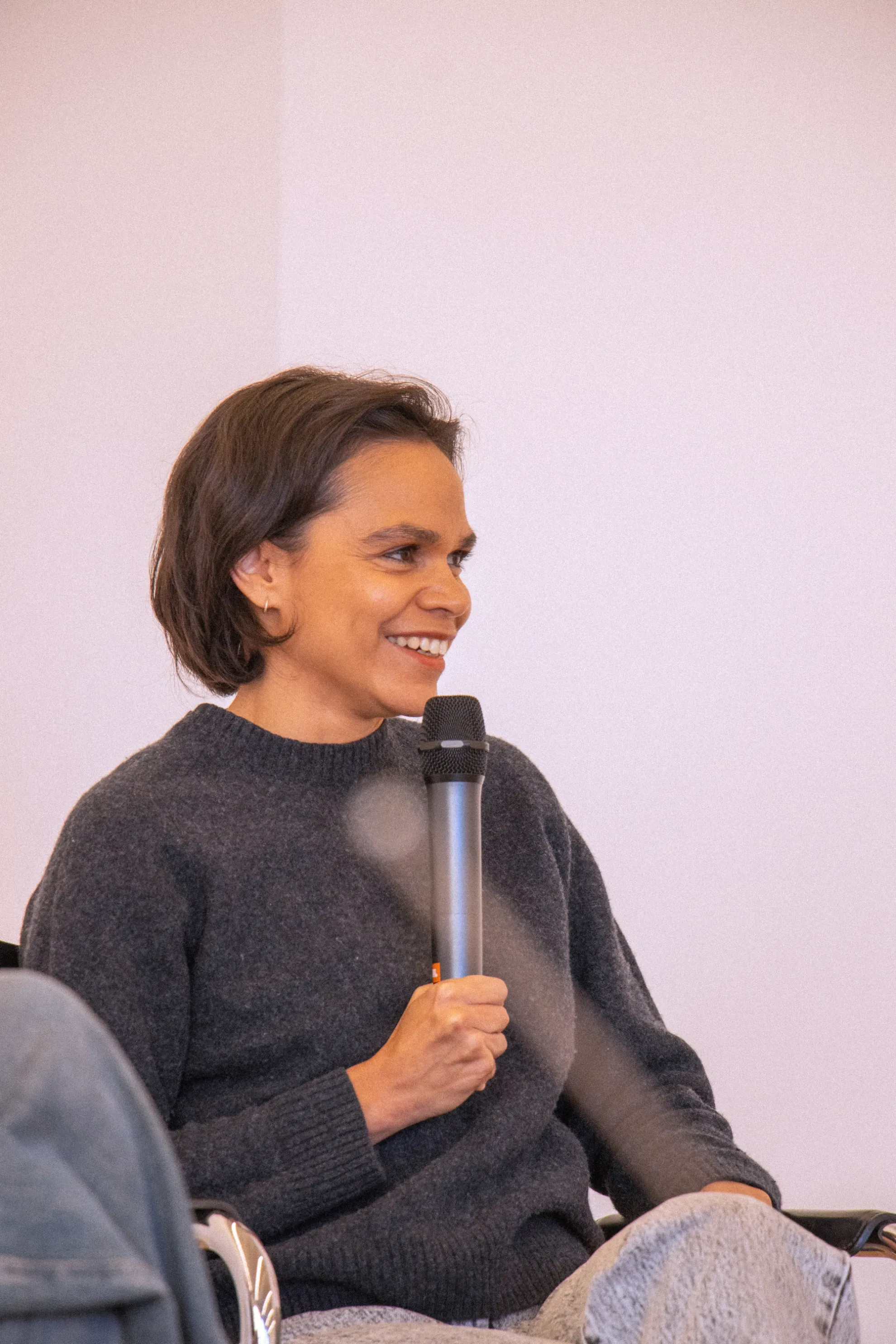
Katie West is an artist and Yindjibarndi woman based in Noongar Ballardong Country. Her practice is grounded in the understanding that the health of human society and Ngurra (Country) mirror one another. Through installations of found objects and sound transmitted via radios, textiles, video and photography, Katie’s works invite attention to the ways we weave our stories, places, histories, and futures.
Michael Gentle is a curator and writer in Naarm/Melbourne. He is a Nyoongar man, with convict and Irish ancestry. Presently, he works at the National Gallery of Victoria as Curator, Australian and First Nations Art where he has curated exhibitions such as Another Other: the Photo-Politics of Gary Lee. In 2025, he will continue his studies at the University of Oxford, pursuing a Masters in History of Art and Visual Culture.